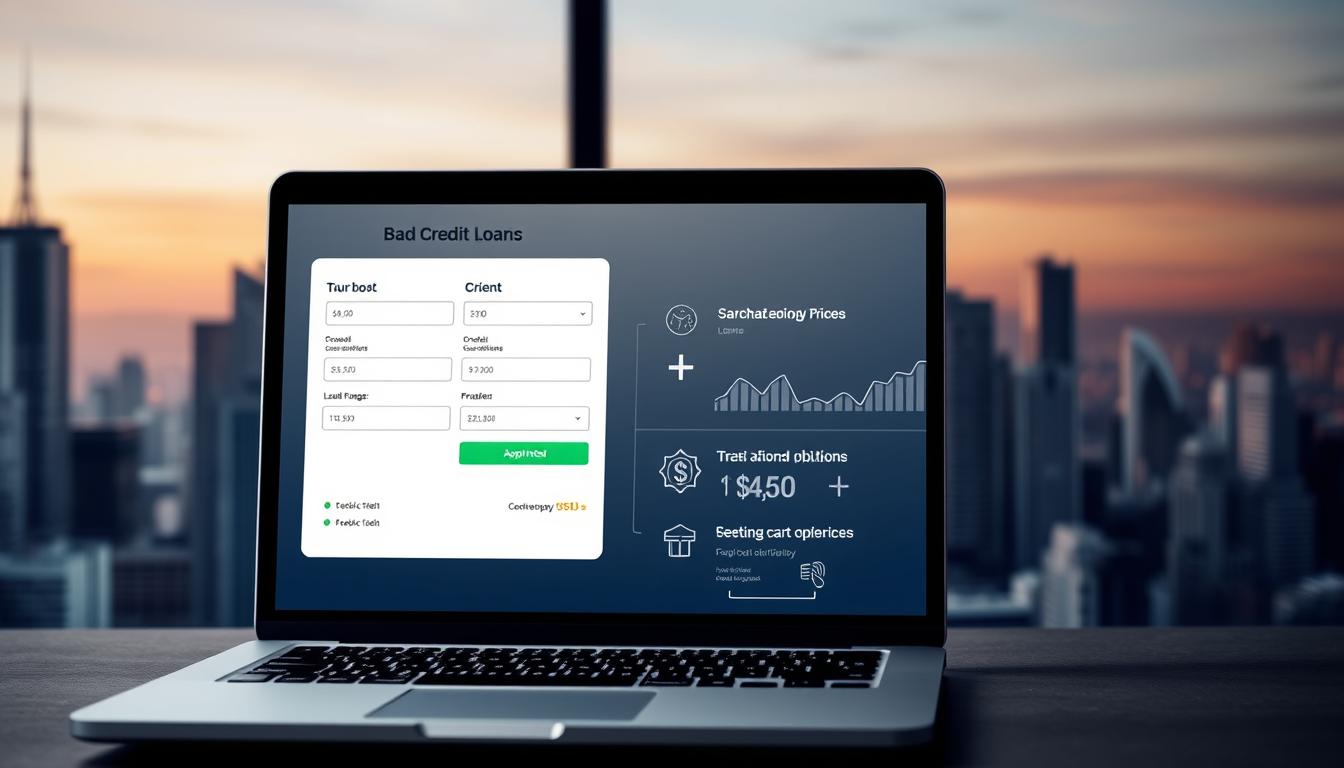Refinance Student Loans: Lower Payments, Faster Payoff
Nearly 45 million Americans owe over $1.7 trillion in education debt. This shows the need for good debt management. Refinancing can help by swapping high-interest loans for ones with lower costs.
Getting a lower interest rate can cut down monthly payments. This means more money for other needs or savings. It makes managing money easier and helps pay off debt faster.
Key Takeaways
- Refinancing can lead to lower monthly payments.
- A faster payoff is achievable with a lower interest rate.
- Borrowers can potentially save thousands in interest.
- Replacing high-interest loans with a single, lower-cost loan simplifies financial management.
- Refinancing through a private lender offers flexible terms.
What is Student Loan Refinance?
Refinancing your student loans can change your financial health for the better. We’ll look into what student loan refinance means and how it helps borrowers.
Definition and Explanation
Student loan refinance means swapping one or more loans for a new one. This new loan usually has a lower interest rate and a single monthly payment. It can make your finances simpler and save you money in the long run.
By refinancing, you can switch to a fixed rate from a variable one. Or, you might get a lower rate than before. This can mean lower monthly payments and less interest paid over time.
How it Works
The refinance process starts with applying for a new loan from a private lender. You’ll need to share your income and credit score to see if you qualify.
After approval, the new lender pays off your old loans. You then have just one loan and one monthly payment. This makes managing your debt easier.
| Loan Type | Original Interest Rate | Refinanced Interest Rate |
|---|---|---|
| Fixed Rate Loan | 6.00% | 4.50% |
| Variable Rate Loan | 5.50% | 4.00% (Fixed) |
| Multiple Loans | Average 7.00% | 5.25% |
The table shows how refinancing can cut interest rates a lot. This applies to fixed, variable, or multiple loans.
Benefits of Refinancing Your Student Loans
Refinancing your student loans offers many benefits. It can make your loan payments easier to manage.
Lower Interest Rates
One big advantage is getting lower interest rates. By refinancing, you can get rates that are better than your current ones. This can save you a lot of money over time.
For example, cutting your interest rate from 6% to 4% on a $30,000 loan can save you over $3,000 in 10 years.
Reduced Monthly Payments
Refinancing can also lower your monthly payments. You might get a longer loan term or a lower interest rate. This makes it easier to handle your debt.
- Lower payments mean more money for other financial goals.
- It can also help your credit score by making it easier to pay on time.
Simplified Payments
Another great benefit is simplifying payments. You can combine multiple loans into one. This makes managing your payments easier.
With one loan, you’re less likely to miss payments. This avoids penalties and keeps your finances on track.
Who Should Consider Student Loan Refinance?
Deciding to refinance student loans depends on your personal situation. It’s a good choice for those in a strong financial spot.
Refinancing can bring many benefits, but it’s not for everyone. Some groups might find it very helpful.
Recent Graduates
Recent graduates with good credit and a steady job might want to refinance. This can lead to lower interest rates and better loan terms.
Borrowers with Good Credit
Those with high credit scores can get better rates when refinancing. A good credit score can greatly affect the interest rate offered by lenders. This makes monthly payments easier to handle.
Those Seeking Better Loan Terms
People looking to simplify payments or lower their monthly costs might refinance. By doing so, they can combine multiple loans into one with a lower monthly payment. This makes managing finances easier.
Before refinancing, it’s key to check your financial health and goals. If you have a stable income, good credit, and want better loan terms, refinancing could be a good choice.
When is the Right Time to Refinance?
To get the most out of refinancing, knowing when to do it is key. You need to look at market trends, your financial health, and the loan terms. Refinancing at the best time can save you a lot and make payments easier.
Market Trends
Market trends are very important in deciding when to refinance. Interest rates are a big deal; when they’re low, refinancing can save you a lot. Keep an eye on rate changes and refinance when rates are good.

Personal Financial Situations
Your financial situation is also crucial. If your credit score has improved since you got your loans, you might get better rates. Also, having a steady income and less debt makes you a better candidate for refinancing.
- Improved credit score
- Stable income
- Lower debt-to-income ratio
Loan Types and Terms
The type of loan you have and its terms matter too. For example, if you have a variable-rate loan, you might want to switch to a fixed-rate loan to avoid rate hikes. Knowing all about your loan is important.
| Loan Type | Interest Rate | Refinancing Benefit |
|---|---|---|
| Variable-Rate Loan | Variable | Potential to fix rate, avoid increases |
| Fixed-Rate Loan | Fixed | Possibility of lowering rate if market rates drop |
How to Refinance Student Loans
Refinancing student loans involves several key steps. These steps can help you manage your finances better. It can make your payments easier and possibly lower your interest rates.
Choose a Lender
To start, you need to select a reputable lender. Look for one with good interest rates and flexible terms. Compare different lenders, like banks and online services, based on rates, repayment options, and customer service.
Gather Required Documents
After picking a lender, you’ll need to gather the necessary documents. Lenders usually ask for proof of income, credit reports, and loan statements. Make sure you have all these documents ready to make the application smoother.
Submit Your Application
With your documents in hand, the next step is to submit your application to the lender. They will check your credit and verify your information. Be ready to give more details if they ask during the review.
By following these steps, you can refinance your student loans successfully. This might improve your financial situation. Always check the new loan’s terms to make sure they fit your financial goals.
Key Factors to Consider Before Refinancing
Refinancing your student loans needs careful thought. You must understand the factors that affect your loan’s cost and repayment terms. This ensures refinancing meets your financial goals.
Interest Rates
The interest rate on your refinanced loan is key. A lower student loan refinance rate can cut down what you pay over time. It’s wise to compare rates from different lenders to get the best deal. For example, a study shows the value of shopping for the best rates.
Loan Terms
The loan terms of your refinanced loan matter a lot. They affect your monthly payments and the loan’s total cost. Longer terms mean lower monthly payments but more interest paid. Shorter terms save on interest but increase monthly payments.
Fees and Penalties
Understanding fees and penalties is also crucial. This includes origination fees, late fees, and prepayment penalties. Some lenders charge fees that increase the loan’s cost. Always check the agreement for fees before signing. It’s smart to ask about fees when comparing lenders.
By thinking about interest rates, loan terms, and fees and penalties, you can make a smart choice about refinancing. This careful approach helps you navigate refinancing confidently and could save you money in the long run.
Potential Drawbacks of Refinancing
Refinancing student loans has its downsides. It’s key to know these before deciding. Refinancing can bring lower interest rates and easier payments. Yet, there are things to think about.
Loss of Federal Benefits
One big drawback is losing federal benefits from your original loans. Refinancing federal loans means giving up income-driven repayment plans and loan forgiveness. These are vital for those struggling to pay or working in public service.
Income-driven plans can make payments fit your income and family size. Forgiveness programs, like Public Service Loan Forgiveness (PSLF), can wipe out part or all of your loans after qualifying payments. By refinancing, you lose access to these programs.
Impact on Credit Score
Refinancing can also hurt your credit score. Applying for a refinance loan leads to a hard credit inquiry, which can lower your score. This effect is more pronounced if you have a thin credit file or apply for many loans quickly.
Refinancing means getting a new loan to pay off old ones. Be careful not to get a longer term or higher interest rate, even if payments are lower. Always review your new loan’s terms before refinancing.
To lessen these risks, it’s important to:
- Carefully review the terms of your new loan
- Consider whether the benefits of refinancing outweigh the potential drawbacks
- Check your credit report and score before applying
- Shop around for lenders to find the best rates and terms
Frequently Asked Questions About Refinance
Exploring student loan refinance can be complex. It’s key to answer common questions. This helps borrowers make smart choices.
Can I Refinance Multiple Loans?
Yes, you can refinance multiple loans. Lenders often let you combine loans into one. This can lower your interest rate and monthly payment.
Refinancing multiple loans helps if you have loans with different rates and terms. It simplifies payments and might cut down on interest costs.
Is There a Minimum Credit Score Required?
Lenders set minimum credit score requirements for refinancing. A score of 650-700 is usually the minimum. Good credit scores can lead to better rates and terms.
Checking your credit score and report before applying is crucial. Knowing your credit helps you understand what loan terms you might get. This way, you can make better refinancing choices.

Resources for Student Loan Refinance
To make a smart choice about refinancing your student loans, it’s key to use the right resources. We can look into different options by using student loan refinance resources. This includes tools for comparing lenders and websites for learning about money.
Comparing Lenders
Tools for comparing lenders help us see what each offers. We can look at interest rates, loan terms, and fees. This way, we can find the best lender for us.
Enhancing Financial Literacy
Financial literacy websites offer great tips on handling debt and credit scores. They also help us understand the refinancing process. These sites help us make better financial choices and manage our loans.
By using both lender comparison tools and financial literacy sites, we can improve our refinancing experience. This helps us reach our financial goals.









